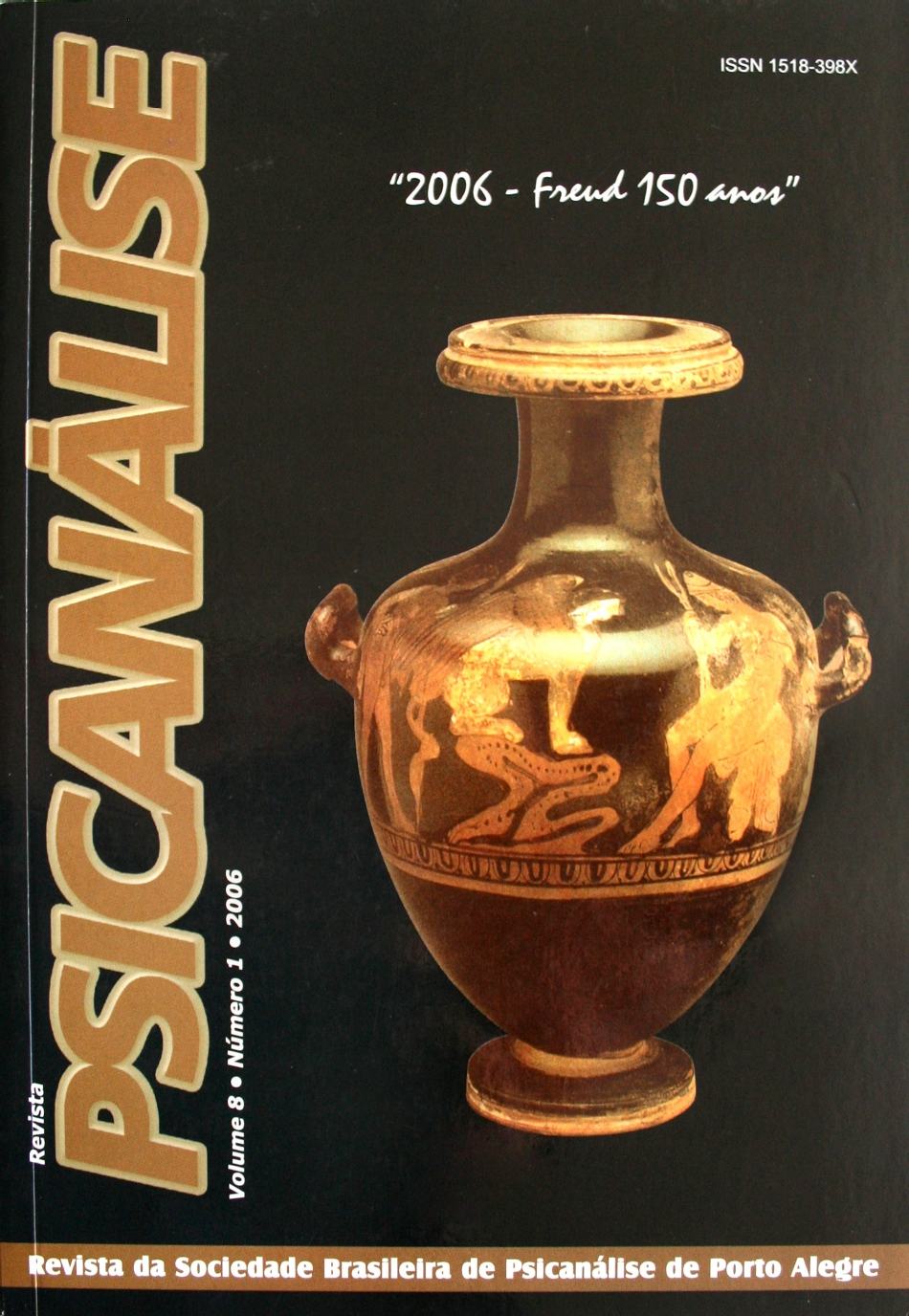Ferenczi and trauma
a short introductory map
DOI:
https://doi.org/10.60106/rsbppa.v8i1.212Keywords:
Trauma, Trangenerationality, Representability, Intrusion, NarcissismAbstract
This study seeks to introduce the main aspects of Ferenczi’s thinking concerning trauma. It emphasizes the importance of this author’s contribution and the de-contextualized and misunderstood way he is usually read. It develops four fundamental points in his theory: that Ferenczi’s theory places the concept of trauma at the center of psychic functioning, giving importance to the action of unconscious communicative processes as a way of incorporating “unconscious primitive impulsive messages”; that trauma effects the structuring of the ego and the subject, producing an “injury to self love and self confidence”, a consistent and lasting state of “narcissistic mortification”; that the suffering deriving from these states of interrupted subjectivity will be effectively approached if the analyst provides a “function of witness”, agreeing to temporarily embody the patient, putting his/her person and analytical competence to this service; and finally that the direction of cure lies in reliving traumatic memory in the analytical relationship, offering the appropriate atmosphere, free from egotistical constitution, with the aim of staunching the mimetic state of eternal repetition of the trauma.
Downloads
References
ABRAHAM, N.; TOROK, M. (1987). La Scorza e il Nocciolo. Roma: Borla, 1993.
BALINT, A. (1935). Le Maniement du Transfert sur la Base des Expériences Ferencziennes. Le Coq-Héron, v.147, p.99-105, 1997.
BALINT, M. (1952). L’Amore Primario. Milão: R. Cortina, 1991.
______. (1969). Il Difetto Fondamentale. Milão: R. Cortina, 1983.
BION, W. R. (1992). Cogitations. Roma: Armando, 1996.
BOKANOWSKI, T. Variations on the Concept of Traumatism: traumatism, traumatic, trauma. International Journal of Psycho-Analysis, London, v.86, p.251-265, 2005.
BORGOGNO, F. Psicoanalisi come Percorso. Turim: Bollati Boringhieri, 1999a.
______. Sándor Ferenczi’s First Paper Considered as a “Calling Card”. International Forum Psychoanalysis, v.8, n.3-4, p.49-256, 1999b.
______. (2000). La “Longue Onde” de la “Catastrophe” e les “Conditions” du Changement Psychique dans la Pensée Clinique de Ferenczi: un hommage au “bébé vivant”. In: ARNOUX, D. J.; BOKANOWSKI, T. (Ed.). Le Nourisson Savant: une figure de l’infantile. Paris: In Press, 2001.
______. (2002). Perché Ferenczi oggi? In: BORGOGNO, F. (Org.). Ferenczi Oggi. Turim: Bollati Boringhieri, 2004.
______. (2004). “A Partially Missing Link”: l’incontro (d’“anima”) ravvicinato tra Ferenczi e Winnicott. Quaderni di Psicoterapia Infantile, v.52, p.11-26, 2005.
BOSCHAN, P. J. Childhood and Trauma. Trabalho apresentado no 44º Congresso da IPA em 2005, ocorrido na cidade do Rio de Janeiro de 28 a 31 jul. 2005.
DI CHIARA, G. L’Inconscio e la Formazione Psicoanalitica. Rivista di Psicoanalisi, v.3, p.445-463, 1999.
FAIMBERG, H. The Telescoping of Generations: listening to the narcissistic links between generations. Londres: Routledge, 2005.
FERENCZI, S. (1908a). Il Significato dell’Eiaculazione Precoce. In: ______. Opere. Milão: R. Cortina, 1989. v.1.
______. (1908b). La Nevrosi alla Luce dell’Insegnamento Freudiano e la Psicoanalisi. In: _____. Opere. Milão: R. Cortina, 1989. v.1.
______. (1908c). Psicoanalisi e Pedagogia. In: ______. Opere. Milão: R. Cortina, 1989. v.1.
______. (1909a). Le Psiconevrosi. In: ______. Opere. Milão: R. Cortina, 1989. v.1.
______. (1909b). Introiezione e Transfert. In: ______. Opere. Milão: R. Cortina, 1989. v.1.
______. (1912). Sintomi Transitori nel Corso dell’Analisi. In: ______. Opere. Milão: R. Cortina, 1989. v.1.
______. (1916). Due Tipi di Nevrosi di Guerra (Isteria). In: ______. Opere. Milão: R. Cortina, 1990. v.2.
______. (1919a). La Tecnica Psicoanalitica. In: ______. Opere. Milão: R. Cortina, 1990. v.2.
______. (1919b). Fenomeni di Materializzazione Isterica. In: ______. Opere. Milão: R. Cortina, 1992. v.3.
______. (1919c). Psicoanalisi delle Nevrosi di Guerra. In: ______. Opere. Milão: R. Cortina, 1992. v.3.
______. (1920-32). Note e Frammenti. In: ______. Opere. Milão: R. Cortina, 2002. v.4.
______. (1921). Osservazioni Psicoanalitiche sul Tic. In: ______. Opere. Milão: R. Cortina, 1992. v.3.
______. (1924). Thalassa: saggio sulla teoria della genitalità. In: ______. Opere. Milão: R. Cortina, 1992. v.3.
______. (1927). L’Adattamento della Famiglia al Bambino. In: ______. Opere. Milão: R. Cortina, 2002. v.4.
______. (1929a). Il Bambino Mal Accolto e la sua Pulsione di Morte. In: ______. Opere. Milão: R. Cortina, 2002. v.4.
______. (1929b). Principio di Rilassamento e Neocatarsi. In: ______. Opere. Milão: R. Cortina, 2002. v.4.
______. (1931). Analisi Infantili con gli Adulti. In: ______. Opere. Milão: R. Cortina, 2002. v.4.
______. (1932a). Confusione di Lingue tra gli Adulti e il Bambino. In: ______. Opere. Milão: R. Cortina, 2002. v.4.
______. (1932b). Diario Clinico. Milão: R. Cortina, 1988.
FERENCZI, S.; RANK, O. (1924). The Development of Psycho-analysis. Madison: International Universities, 1986.
FREUD, S. (1905). Psicoterapia. In: ______. OSF. v.4.
______. (1912). La Dinamica della Traslazione. In: ______. OSF. v.6. _
_____. (1914). Ricordare, Ripetere, Rielaborare. In: ______. OSF. v.7.
______. (1934-1938). Mosè e il Monoteismo: tre saggi. In: ______. OSF. v.11.
FREUD, S.; FERENCZI, S. (1919-1933). The Correspondence. Cambridge: Belknap, 2000. v.3.
HEIMANN, P. (1965). Considerazioni sull’Articolo del Dr. Kernberg sui “Derivati Strutturali dei Rapporti Oggettuali”. Bambini e Non Più Bambini. Roma: Borla, 1992.
______. (1969). Postscriptum a “La Dinamica delle Interpretazioni di Transfert”. Bambini e Non Più Bambini. Roma: Borla, 1992.
KING, P. Affective Response of the Analyst to the Patient’s Communications. International Journal of Psycho-Analysis, London, v.59, p.329-334, 1978.
KLEIN, M. (1946). Note su Alcuni Meccanismi Schizoidi. In: ______. Scritti (1921-1958). Turim: Boringhieri, 1978.
VIÑAR, M. N. Training Analysis and Analytic Training: a problematic boundary. International Journal of Psycho-Analysis, London, v.77, p.41-49, 1996.
WINNICOTT, D. W. (1971). Gioco e Realtà. Roma: Armando, 1976.
Downloads
Published
How to Cite
Issue
Section
License
I attribute the copyrights that belong to me, on this work, to SBPdePA, which may use and publish it by the means it deems appropriate, including on the Internet or in any other computer processing.
















